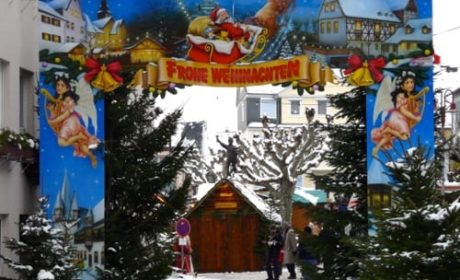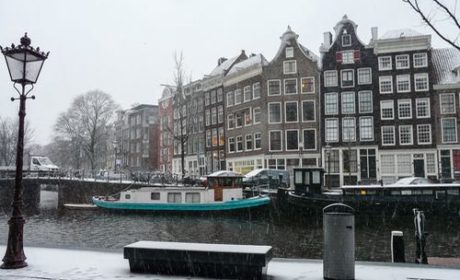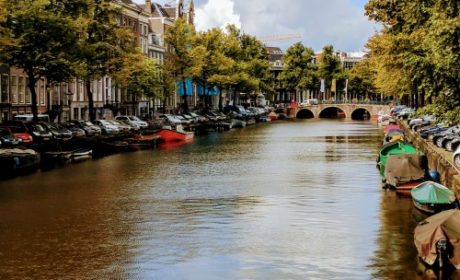Updated 08.04.2018: Walking tours are part of the allure of European river cruising. In today’s guest article, boomer travel writer, Catherine Sweeney, takes us on a stroll as she explores Portuguese history and culture on a Guimaraes walking tour.

Aqui nasceu Portugal” (Portugal was born here), the proud statement seen on the ancient city walls of Guimarães, conveys the fact that the city was the country’s first capital and the birthplace of Portuguese national identity. As part of our Viking River Cruise along the Douro River in northern Portugal, my husband and I took one of the ship’s walking tour excursions to see the city.
Guimaraes walking tour on a December afternoon
On the December afternoon of our visit, the city was quiet with an atmosphere of historic authenticity that I’m told persists even during times when the city is bustling.

The Guimarães city center was designated a UNESCO World Heritage Site in 2001: and, as one would expect, there are plenty of historic sites and tales. Beyond the monuments and museums, Guimarães, Portugal, has a contemporary edge and a thriving modern culture and economy that are partially explained by its generally youthful population.
Home to Minho University, about half of its over 52,000 residents are under 30, making Guimarães one of the youngest cities in Europe. Its designation in 2012 as a European Capital of Culture also provided a boost of recognition for the city’s rich culture, brought economic bonuses, and gained attention with a year of festivities and projects. Four years later, the celebratory decorations are removed, but the momentum remains.

Starting at Castelo de Guimarães
A light rain fell as we began our Guimarães walking tour at the Castelo de Guimarães (Guimarães castle) at the top of the city. Towering over the city center, the 10th-century castle was in excellent position to protect the area from the attacks of the Moors, Normans, and Vikings. It’s said that the first king of Portugal, Afonso Henriques, was born in the castle in the early 11th century.
Declaring himself a knight in 1122 and raising an army at the age of 14 (age of consent at the time), Afonso fought many battles and defeated his own mother’s forces in 1128. After more years of warfare, he conquered the ruling Moors in 1139 effectively gaining independence for the region and leading to the creation of a Portuguese national identity. Following the momentous victory, Afonso was declared king by his troops.
Coming to a statue honoring King Afonso Henriques, our guide pointed out that the top of the sword is missing. We were told that a drunken student unwisely broke off a piece of the sword one night and brandishing it overhead ran naked through Guimarães proclaiming, “I am the King!” Imagine that!

Visiting the Paco dos Duques
Near the castle, distinctive chimneys rise above the Paco dos Duques (Ducal Palace). No longer the palace of dukes, the 15th-century building houses collections of art, tapestries, weapons, and other period treasures. However the top floor is maintained as a residence for the president of Portugal when he visits Guimarães. Located between the castle and the palace, the Igreja de São Miguel do Castelo (Church of St. Michael). houses an impressive granite floor inscribed with the names of knights who died in battle.

Exploring the historic center of Guimarães
My favorite part of touring Guimarães was walking around the historic center with its medieval squares like Praça de S. Tiago (St. James Square), surrounded by colorful balconied homes adorned with flower boxes and hanging laundry.
Although the tables of the outdoor cafes were empty on this rainy afternoon, I imagined how lovely it would be on a sunny day to relax here over coffee or a glass of wine soaking up the Guimarães ambiance.
Through a passageway, we entered Largo da Oliveira (Oliveira Square) also with many shops and cafes where the Salado Monument commemorates Portugal’s victory in the Salado River battle over the Moors who were attempting for the final time to regain control of Portugal.

A salute to Guimarães’ medieval history, but with a contemporary twist, is the avant-garde (and we were told somewhat controversial) rendering of King Afonso Henriques in a stone sculpture found in Largo da Misericordia. It was created by artist João Cutileiro in 2001.
But King Afonso Henriques isn’t the only “king” whose memory is celebrated in Guimarães. The Elvis Bar in the historic city center is a popular night spot with lots of Elvis memorabilia including photos, music, and art.

Browsing for local products is a lesson in Portuguese quality
Through the centuries and still today, wood, leather, silver, and textile crafts have been part of the industry of the city. You’ll find many shops selling local products.
I saw a sign in front of a store advertising its wares that sums up the artistry of the goods I saw at shops in the city center: “Genuine Portuguese high quality products that celebrate the perfect combination between exquisite design and traditional craftsmanship”.
Leaving the historic medieval quarter, we were back on a bustling modern boulevard at Largo Republica do Brasil heading out of the city. Although our time in Guimarães was short, only a few hours, it was long enough to appreciate the centuries of history, modern character, and the importance of Guimarães to the Portuguese people.
More things to do in Guimaraes:
- Tour the Ducal Palace and with a guide dressed as the Duchess of Braganza
- Explore Guimaraes by Hop-on Hop-off bus. Buy your ticket here.
Planning a trip to Portugal? Consider visiting Braga or exploring Lamego.
Disclosure: Viking River Cruises hosted Catherine Sweeney on a Duoro River Cruise that included this Guimarães walking tour.
Have you visited Guimarães? Join the conversation at the My Itchy Travel Feet page on Facebook or send us an email to ask a question or share your experience.



